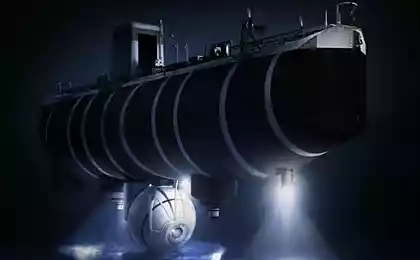1700
Tu-95
Tu-95 (a product "B" on the codification of NATO: Bear - «Bear") - Soviet / Russian turboprop strategic bomber, bomber, the fastest plane spiral, which became one of the symbols of the Cold War.
Last in the world put into service and serially produced turboprop bomber. Had a lot of modifications to current challenges. Last modification designed to engage cruise missiles important objects in the rear of the enemy at any time and under any weather conditions.
Along with the American strategic bomber B-52, Tu-95 - one of the few military aircraft in service continuously for more than half a century.
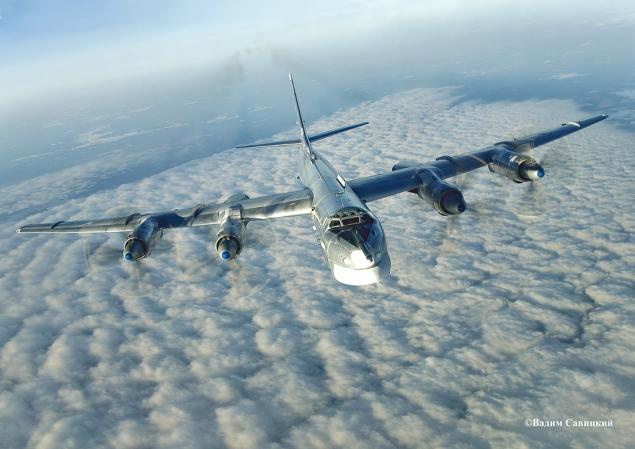
Russian bear
Along with the B-52 Russian strategic bombers Tu-95 bomber is an absolute record as on service life, so for distance and duration flights. It is the world's fastest propeller aircraft and turboprop single serial bomber. Created on orders of Stalin in 2010, the Tu-95 stayed in the air 43 hours flying with five refueling 30,000 kilometers above the five oceans.
From prototype aircraft were only purpose, title and huge screws OKB Zhdanov, has a record (82 percent!) Efficiency in all modes. Screw size and power of the engines led to another feature of the Tu-95 - it is a very noisy plane hear it even sonar submarine system. However, for the solved problems SSBNs this disadvantage is not critical. NATO bomber got codename Bear (Bear), accurately reflect the nature and capabilities of the machine.
Tu-95 had brought on his entire nuclear program of the Soviet Union. He dropped to the New Earth famous "Tsar Bomb" - the most powerful in the history of thermonuclear warheads AN602 equivalent to 50 million tons of TNT. Electromagnetic pulse from a bomber, remove 45 kilometers, turn the meter off and stop the engine. The engines of the Tu-95 launched in the fall: the first seven thousand meters, the second in five ... He sat down on the three aircraft - the fourth engine, as it turned out on the ground, and burned out of order. Charred fuselage, wings and electrical wiring, melted and deformed aluminum parts.
In the early 60's was built experimental Tu-95 with a nuclear reactor in the fuselage - he had to rotate two of the four engines. Modifications to working on tests orbital plane of the epic. In the 70s bomber drove from Moscow to Novosibirsk Glider Tu-144 65-meter-long aircraft bomb racks hitched to the strong and able to take without problems.
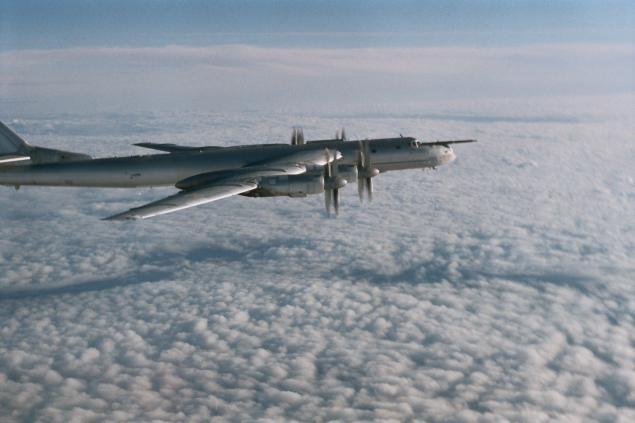
However, the main purpose of the Tu-95 was and remains alert. The aircraft is armed with six cruise missiles X-55 with a range of up to 3 thousand kilometers and a nuclear warhead. In 2008, the bombers began equipping high-precision missiles X-101 and X-555. They are placed in hidden in the fuselage drum launcher. Another 10 aircraft can carry missiles on pylons under the wings.
Operation modernized Tu-95 will last at least until 2025, when they were replaced by submarine to come fifth-generation PAK DA.
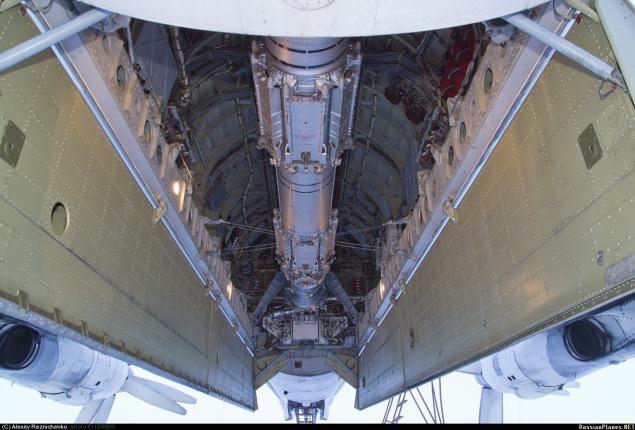

A favorite pastime of Tu-95 during the "Cold War" was to scare the American carriers. The crew reported the coordinates of the order and a huge plane, down to 200 meters - not spotted the ship radars - silver shadow glided over the waves. Approaching the ship bomber roared passed over the flight deck, pilots photographed potential enemy and showed encouraging gestures in the windows. After hooligans flew carrier-based fighter, but there was nothing they could not. And in 1966, a supersonic Lightning, scrambled to intercept appeared at the borders of the United Kingdom of the Tu-95, maneuvered before unfortunate that crashed.
Tu-95, accompanied by the F-15
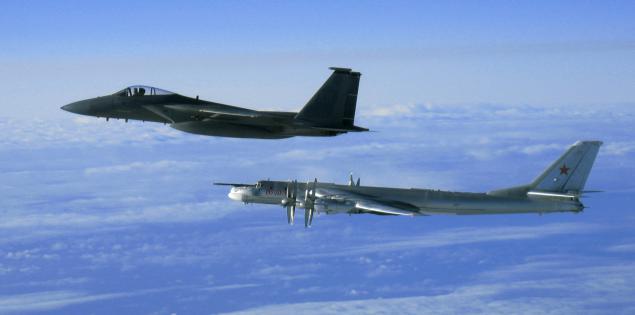
NK-12 engine is still the most powerful turboprop engine in the world. NK-12 has a 14-stage compressor and a five-speed high-efficiency turbine. To adjust the compressor for the first time on this engine installed bleed valves. Efficiency of the turbine engine NK-12 is 34%, which is a record. On the engine NK-12 was first introduced a unified system of fuel control, constructed in a single unit (ie. N. Command-fuel unit).
High engine power and screw design determines its unparalleled noise; Tu-95 is one of the noisiest aircraft in the world and even pinpoint the sonar systems of submarines ([6]), but this is not critical when applying nuclear missile strikes.
Torque transmission on coaxial screws aircraft provided a unique in-line differential gear, the creation of which he immediately put his hand ND Kuznetsov. In the design and manufacture of gear has been used a number of unique technical solutions, and later found wide application in other types of aircraft engines.
Coaxial screws with variable pitch (AB-60K) installed on the Tu-95, have a diameter of 5 to 6 meters and have been developed in the OKB-150 (later Stupinskoe KBM, now - SPE "Aerosila"). The head of the OKB-150, KI Zhdanov, received in 1957 for their development of the Lenin Prize.
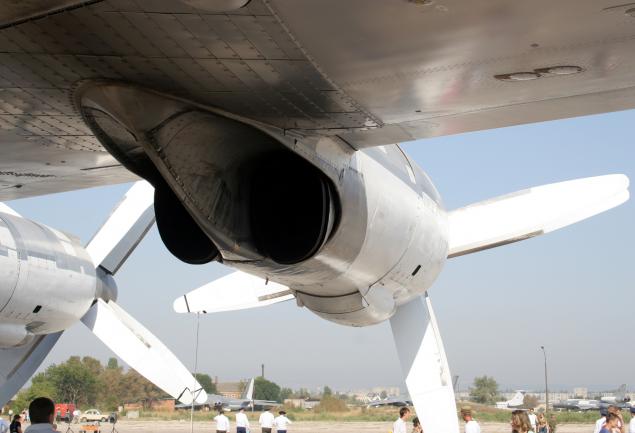

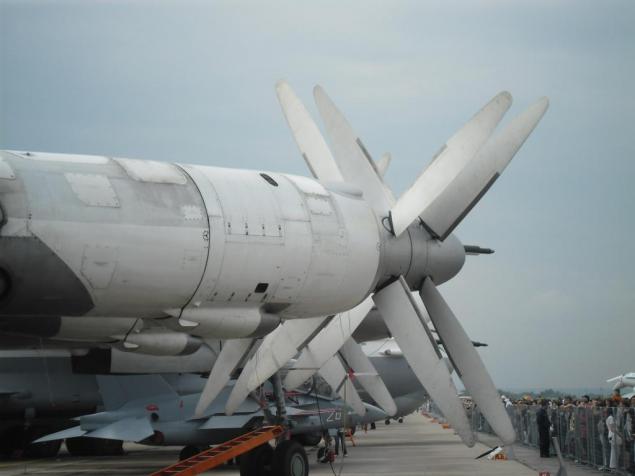
Armament
Bomb load Tu-95 can reach 12,000 kg. In the fuselage bomb bay can be accommodated svobodnopadayuschie (including nuclear) bombs caliber up to 9000 kg.
Tu-95KD and TU-95-20 armed cruise missiles X-20 with a nuclear warhead designed to hit targets at distances radiocontrast 300-600 km.
Tu-95B (there was a one-off) was converted for use as a means of delivering the world's most powerful thermonuclear bomb. The weight of the bomb was 26, 5 tons, and the power of TNT - 50 megatons. After the test, the king-bomb October 30, 1961 this aircraft intended more unused.
Tu-95MS, are the backbone of Russian strategic aviation, is the carrier of cruise missiles X-55. In a modification of the Tu-95MS6 in the cargo hold on the rocker launcher drum which is located six such missiles. In a modification of the Tu-95MS16 in addition to vnutrifyuzelyazhnyh launcher, suspension provided ten more X-55 missiles on four underwing holders (but this is prohibited by international agreements). Equipment svobodnopadayuschie ammunition aircraft dismantled.
Defensive armament Tu-95 consists of 23-mm aircraft cannons. On older versions of the aircraft are six paired guns AM-23 in three defensive infantry units (upper, lower and aft), and only two guns AM-23 or GS-23 Tu-95MS in the stern.
Fodder plant with guns AM-23 (note the thickness of the glass cockpit)
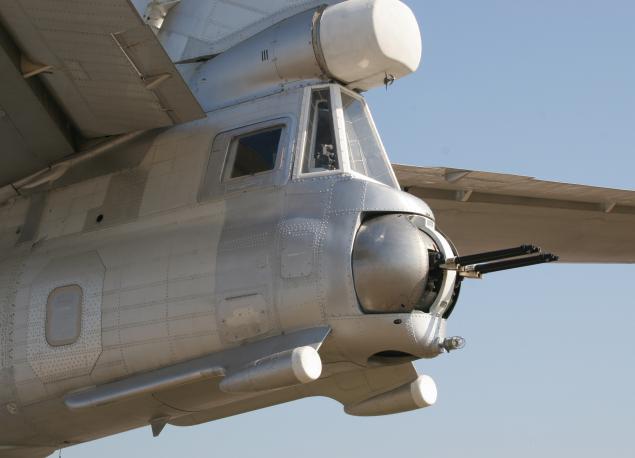
Some Tu-95MS named after the city.
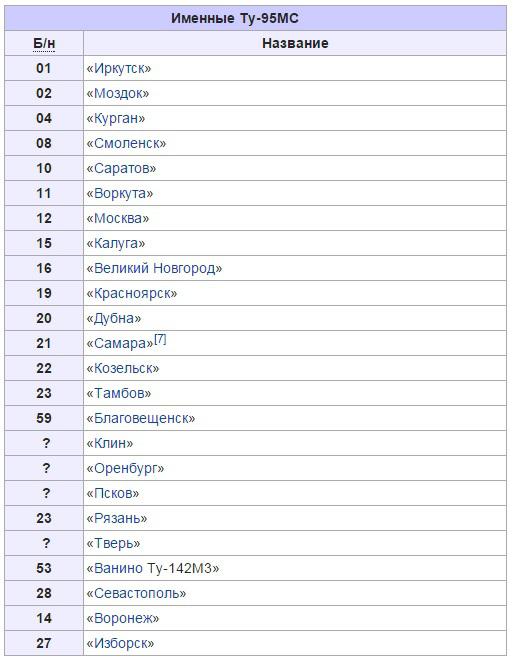
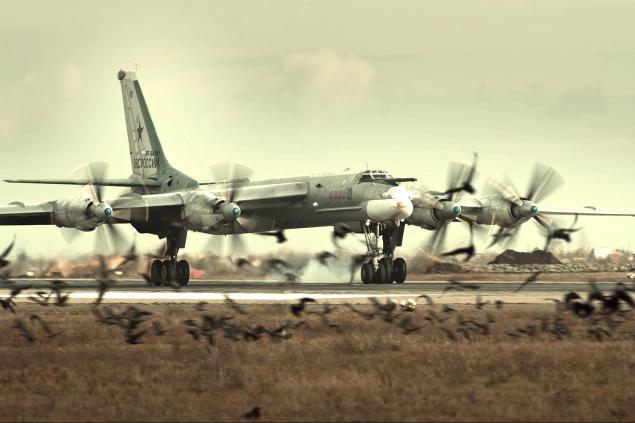
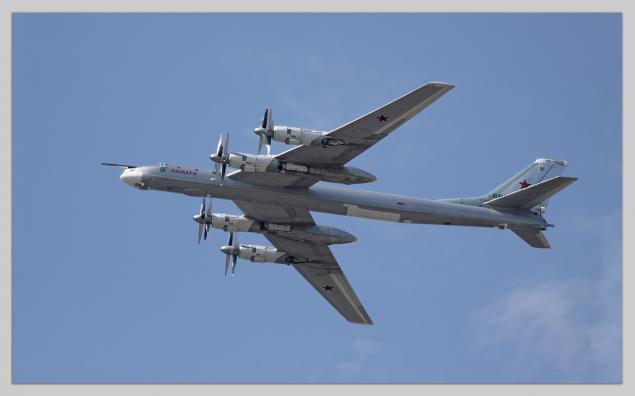
Onboard radar
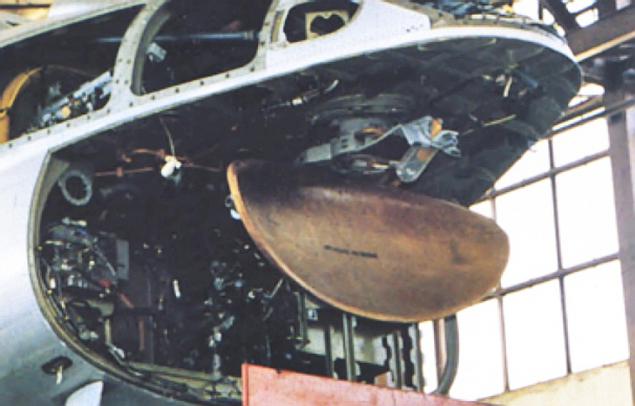
Cockpit
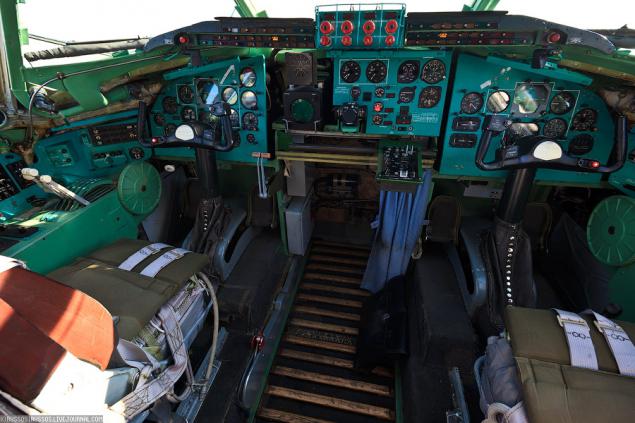
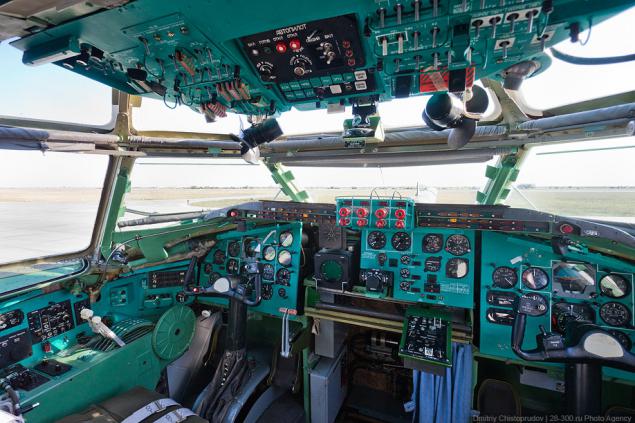
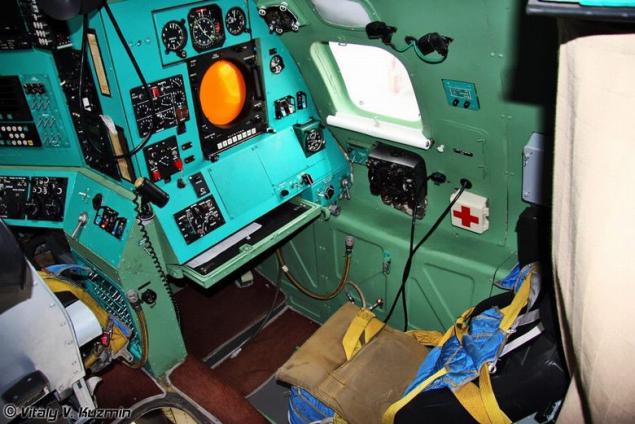
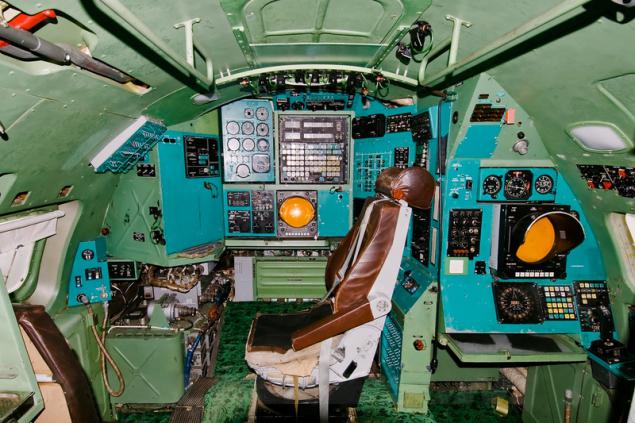
And more photos ...
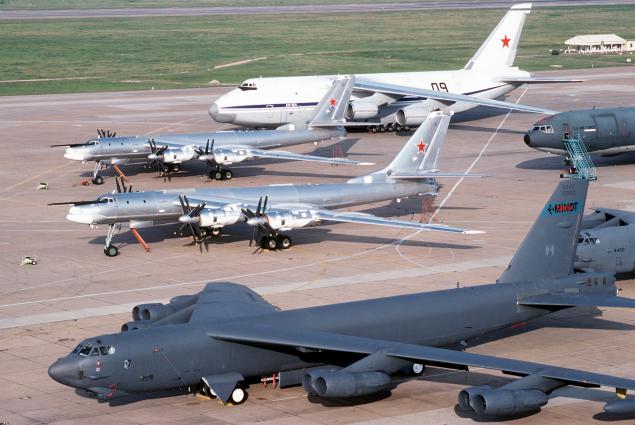
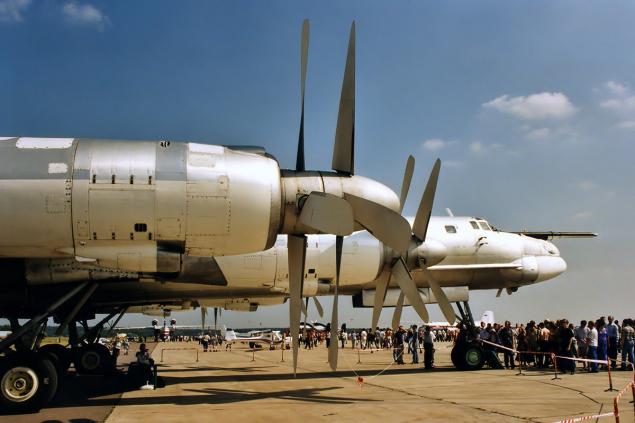
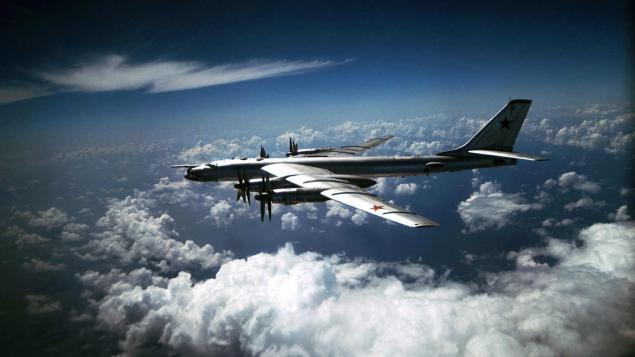
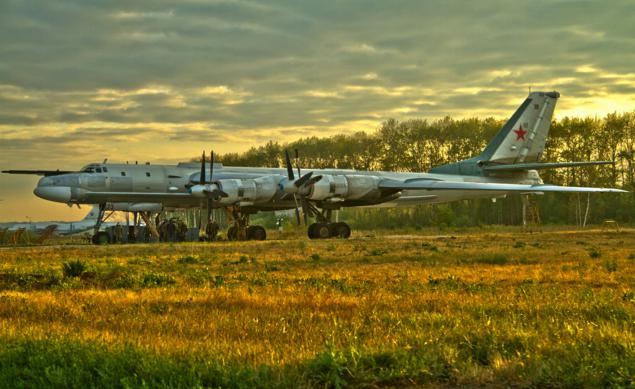
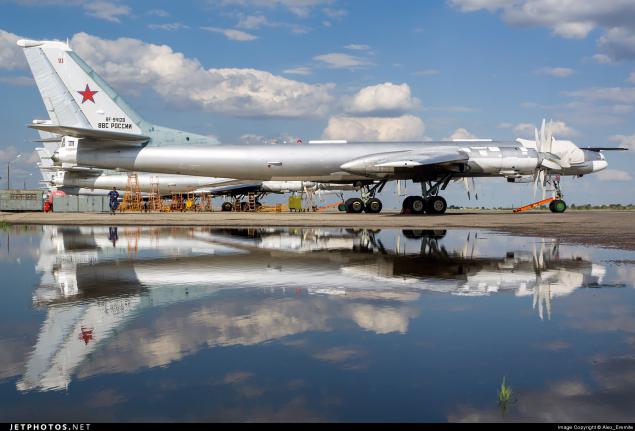
Last in the world put into service and serially produced turboprop bomber. Had a lot of modifications to current challenges. Last modification designed to engage cruise missiles important objects in the rear of the enemy at any time and under any weather conditions.
Along with the American strategic bomber B-52, Tu-95 - one of the few military aircraft in service continuously for more than half a century.

Russian bear
Along with the B-52 Russian strategic bombers Tu-95 bomber is an absolute record as on service life, so for distance and duration flights. It is the world's fastest propeller aircraft and turboprop single serial bomber. Created on orders of Stalin in 2010, the Tu-95 stayed in the air 43 hours flying with five refueling 30,000 kilometers above the five oceans.
From prototype aircraft were only purpose, title and huge screws OKB Zhdanov, has a record (82 percent!) Efficiency in all modes. Screw size and power of the engines led to another feature of the Tu-95 - it is a very noisy plane hear it even sonar submarine system. However, for the solved problems SSBNs this disadvantage is not critical. NATO bomber got codename Bear (Bear), accurately reflect the nature and capabilities of the machine.
Tu-95 had brought on his entire nuclear program of the Soviet Union. He dropped to the New Earth famous "Tsar Bomb" - the most powerful in the history of thermonuclear warheads AN602 equivalent to 50 million tons of TNT. Electromagnetic pulse from a bomber, remove 45 kilometers, turn the meter off and stop the engine. The engines of the Tu-95 launched in the fall: the first seven thousand meters, the second in five ... He sat down on the three aircraft - the fourth engine, as it turned out on the ground, and burned out of order. Charred fuselage, wings and electrical wiring, melted and deformed aluminum parts.
In the early 60's was built experimental Tu-95 with a nuclear reactor in the fuselage - he had to rotate two of the four engines. Modifications to working on tests orbital plane of the epic. In the 70s bomber drove from Moscow to Novosibirsk Glider Tu-144 65-meter-long aircraft bomb racks hitched to the strong and able to take without problems.

However, the main purpose of the Tu-95 was and remains alert. The aircraft is armed with six cruise missiles X-55 with a range of up to 3 thousand kilometers and a nuclear warhead. In 2008, the bombers began equipping high-precision missiles X-101 and X-555. They are placed in hidden in the fuselage drum launcher. Another 10 aircraft can carry missiles on pylons under the wings.
Operation modernized Tu-95 will last at least until 2025, when they were replaced by submarine to come fifth-generation PAK DA.


A favorite pastime of Tu-95 during the "Cold War" was to scare the American carriers. The crew reported the coordinates of the order and a huge plane, down to 200 meters - not spotted the ship radars - silver shadow glided over the waves. Approaching the ship bomber roared passed over the flight deck, pilots photographed potential enemy and showed encouraging gestures in the windows. After hooligans flew carrier-based fighter, but there was nothing they could not. And in 1966, a supersonic Lightning, scrambled to intercept appeared at the borders of the United Kingdom of the Tu-95, maneuvered before unfortunate that crashed.
Tu-95, accompanied by the F-15

NK-12 engine is still the most powerful turboprop engine in the world. NK-12 has a 14-stage compressor and a five-speed high-efficiency turbine. To adjust the compressor for the first time on this engine installed bleed valves. Efficiency of the turbine engine NK-12 is 34%, which is a record. On the engine NK-12 was first introduced a unified system of fuel control, constructed in a single unit (ie. N. Command-fuel unit).
High engine power and screw design determines its unparalleled noise; Tu-95 is one of the noisiest aircraft in the world and even pinpoint the sonar systems of submarines ([6]), but this is not critical when applying nuclear missile strikes.
Torque transmission on coaxial screws aircraft provided a unique in-line differential gear, the creation of which he immediately put his hand ND Kuznetsov. In the design and manufacture of gear has been used a number of unique technical solutions, and later found wide application in other types of aircraft engines.
Coaxial screws with variable pitch (AB-60K) installed on the Tu-95, have a diameter of 5 to 6 meters and have been developed in the OKB-150 (later Stupinskoe KBM, now - SPE "Aerosila"). The head of the OKB-150, KI Zhdanov, received in 1957 for their development of the Lenin Prize.



Armament
Bomb load Tu-95 can reach 12,000 kg. In the fuselage bomb bay can be accommodated svobodnopadayuschie (including nuclear) bombs caliber up to 9000 kg.
Tu-95KD and TU-95-20 armed cruise missiles X-20 with a nuclear warhead designed to hit targets at distances radiocontrast 300-600 km.
Tu-95B (there was a one-off) was converted for use as a means of delivering the world's most powerful thermonuclear bomb. The weight of the bomb was 26, 5 tons, and the power of TNT - 50 megatons. After the test, the king-bomb October 30, 1961 this aircraft intended more unused.
Tu-95MS, are the backbone of Russian strategic aviation, is the carrier of cruise missiles X-55. In a modification of the Tu-95MS6 in the cargo hold on the rocker launcher drum which is located six such missiles. In a modification of the Tu-95MS16 in addition to vnutrifyuzelyazhnyh launcher, suspension provided ten more X-55 missiles on four underwing holders (but this is prohibited by international agreements). Equipment svobodnopadayuschie ammunition aircraft dismantled.
Defensive armament Tu-95 consists of 23-mm aircraft cannons. On older versions of the aircraft are six paired guns AM-23 in three defensive infantry units (upper, lower and aft), and only two guns AM-23 or GS-23 Tu-95MS in the stern.
Fodder plant with guns AM-23 (note the thickness of the glass cockpit)

Some Tu-95MS named after the city.



Onboard radar

Cockpit




And more photos ...


















